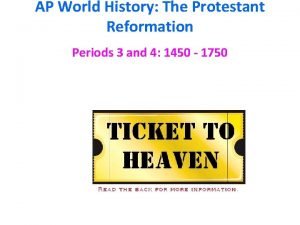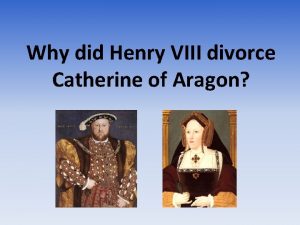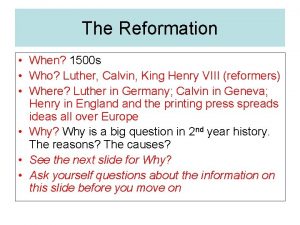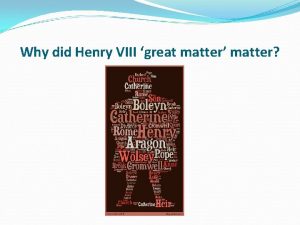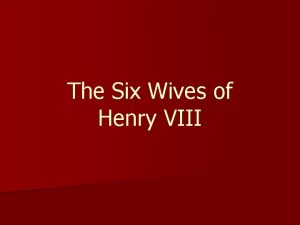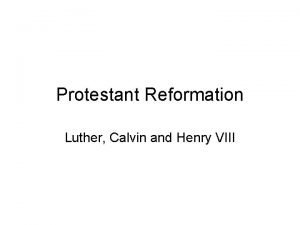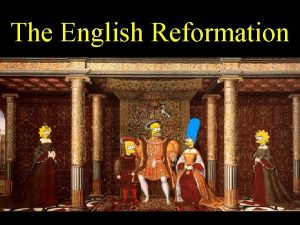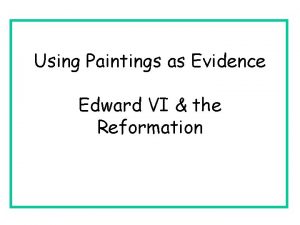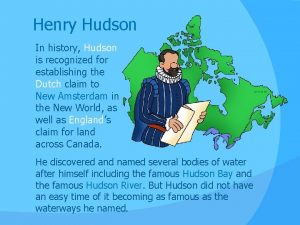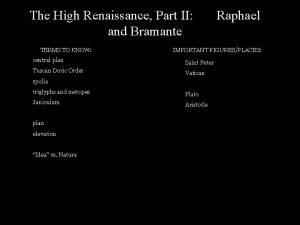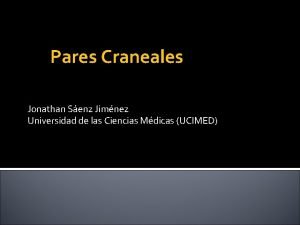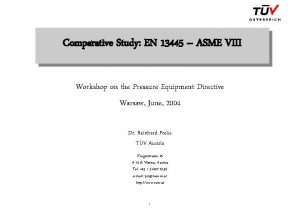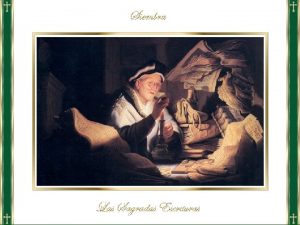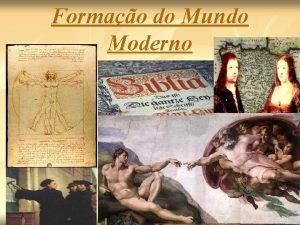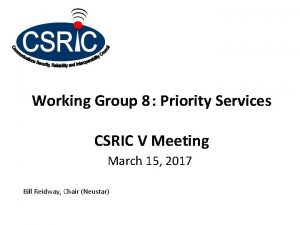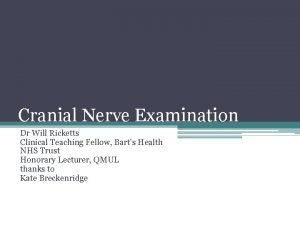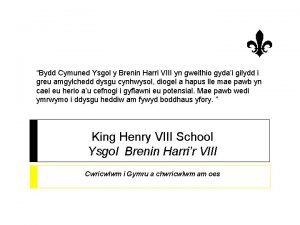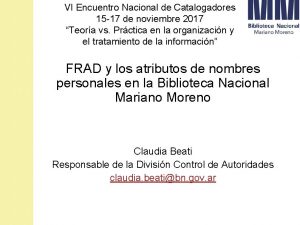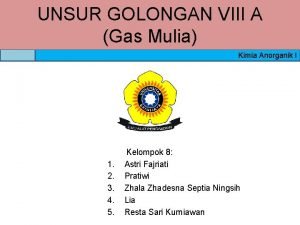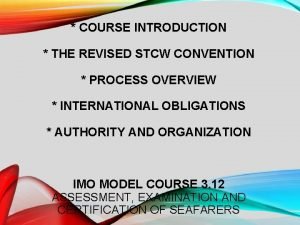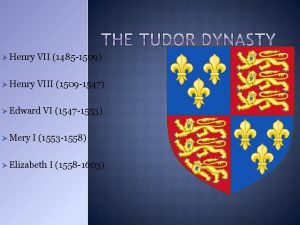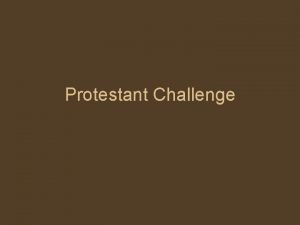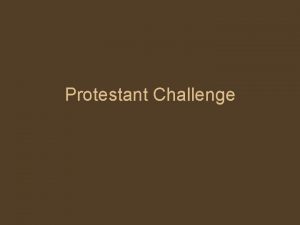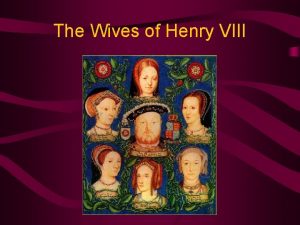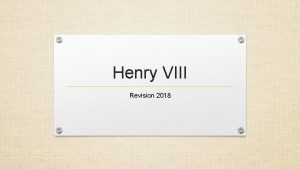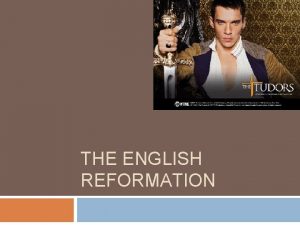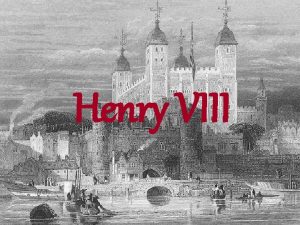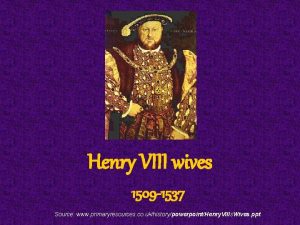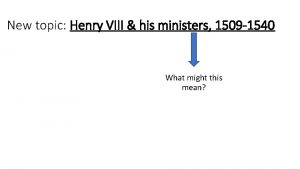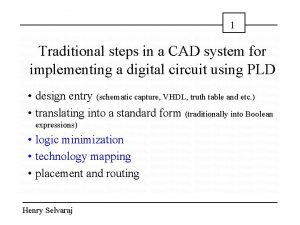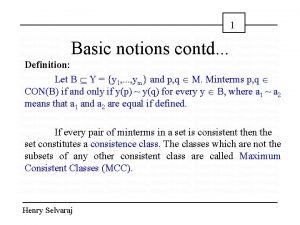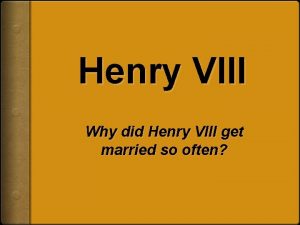The Reign of Henry VIII 1509 47 1

















































- Slides: 49

The Reign of Henry VIII 1509 -47 1. How effectively did the Tudors restore and develop the powers of the Monarchy? 2. In what ways and how effectively was England governed during this period? 3. How did relations with foreign powers change and how was the succession secured? 4. How did English society and economy change & with what effects? 5. How far did intellectual and religious ideas change and develop and with what effects? 6. How important was the role of key individuals and groups and how were they affected by developments?

Becoming King

The Legacy Of Henry VII • In 1485, England was financially and socially unstable following the effects of the War Of The Roses. Through his thirty years on the throne he managed to bring England the realm to stability. • He was the first monarch to leave their accounts of the throne “in the black”. He left £ 300, 000 in jewels and plates for his successor and £ 10, 000 in cash. • "the crown was vastly stronger than it had been in 1485, but it was no nearer to being absolute“. • There was a substantial flow of income through taxes of different kinds even through some may have been unpopular with the people of England the nobles. • Henry VII died, leaving peaceful foreign policies so that England wasn’t at war. • He managed to leave an effective way of government where the king could rule with his councillors.

Henry VIII initial actions and aims Initial actions • • He used his money that was left behind immediately to finance his aggressive foreign policies like the invasion in the south west of France in 1513. He arrested Emspon and Dudley for their illegal ways of obtaining taxes through crown lands during the reign of Henry VII. The conciliar form of government was removed after the increasing influence of Thomas Wolsey in 1514. There were also many cancelled bonds and recognizances and the council learned in law was also abolished. Initial aims • • • He wanted to establish status amongst the European monarchs. He tired to pursuit military glory with led to war with powerful Charles v but with mixed occasional alliances. Another aim was to re-establish the role of the nobility. Nobles didn’t achieve political domination but henry tired to promote their interest of Thomas Wolsey. He also wanted to establish himself as a successful warrior king as he went to war with powerful countries.

Henry VIII character • • • Aged 17 No experience of government Little work ethic “the spare, not the heir” Unstable Enjoyed sports and hunting

How he became king • In 1502, Henry VIII older brother prince Author died and at 11 years old Henry viii was the heir of England. The following year saw the death of his mother, who he was very close with. • The relationship between henry and his father wasn’t as close as him and his mother, as he favoured his eldest son as it was seen that he would take throne. • Prince Henry was kept in seclusion in his apartments, which could be reached only through the King's. He was allowed only the company of his tutors, servants and guards • King Henry VII died on 21 April 1509 and the early life of Henry ended when he succeeded to the throne of England when he was nearly 18 years old.

Government: The Rise of Wolsey Hannah Grainger

Wolsey’s titles in Church and State • 1513: Dean of York and Bishop of Tournai • 1514: Made Bishop of Lincoln then Archbishop of York • 1515: Made Cardinal by Pope Leo X, also became Lord Chancellor in Henry’s government when Warham resigned • 1518: Appointed Papal Legate by Leo X

Reasons • Henry was in favour of the appointment of Wolsey as it shows the nobility that their status isn’t as powerful/important than they think • He gained a degree at Oxford at the age of 15, therefore his intelligence proved sufficient enough for him to carry out such high positions i. e. Cardinal • Henry wasn’t particularly interested in government, therefore, he left Wolsey in control of the government

Interpretations - Described as the “alter-rex”, meaning the alternative king which could be seen as a threat to Henry’s position as King, which could have been a main reason for his downfall - The nobility was threatened by Wolsey’s appointment as Cardinal due to his background – son of a butcher

Character Butcher’s son – not from an important background Well educated – went to Oxford His enemies saw him as arrogant and vindictive He used his legal powers as Lord Chancellor and network of informants to intimidate anyone he saw as a rival • Proud and ostentatious • Organised • Able to guess the King’s demands, allowing him to progress further • •

Wolsey’s domestic policies • Law & Order + Being ‘Lord Chancellor meant that Wolsey had full power over law and order. + Wished to change the use of ‘common law’ (used since William the Conqueror) to ‘civil law. ’ + Creates court of chancery, using the foundations of ‘civil law. ’ (deal with matters such as: civil jurisdiction, property, contracts and wills) + 7% rise in cases being taken to court - Eventually cases became to frequent, meaning the court was slow paced and highly costly. (Matters only made worse by Wolsey being distracted by foreign policy. ) - Recorded abuses of power within law, e. g. : Sir Amya Paulet who was sent to court for daily attendance for 5 years and threatened that under the law he would lose everything if he did not attend, (due to Wolsey withholding a personal grudge upon him. )

• Star Chamber + Reformed in May 1516. + 10 X the amount of cases under Henry VIII’s reign (high percentage of cases came to a judgement) + Political weapon against the nobility (increases Henry’s power) • Finance 1514 (Subsidy): Replacement of the ‘fifteenth and tenths’ taxation (that led to starvation. ) + Based upon ability to pay (aided working class families and increased government revenue 1515(Act of Resumption): wished to increase revenue from crownlands (lost due to Herny. VIII) - Income decrease by 25, 000 per annum + Few crown lands returned 1523(Subsidy): Parliament grant Wolsey the subsidy to raise funds to fight France - Only 150, 000 of the 800, 000 needed was raised throughout the instalments Clear resentment for the subsidy, War in France was not successful proving pointless 1525(Amicable Grant): More revenue needed to support Henry to attack vulnerable France - Parliament refuse to raise extraordinary revenue Causes near rebellion in East Anglia of 20, 000 men Henry had to abandon the grant, whilst the revenue was not collected - BOP: -Collected: £ 322, 099 in subsidies. 240, 000 in clerical taxes. 260, 000 in forced loans. -Gov Expenditure: 1. 7 million between 1509 -1520.

• Church - As Papal Legate, Wolsey had more power than the Archbishop of Canterbury Enforced wide spread corruption within the church, Personal examples being Wolsey lack of celibacy whilst he continued with his non-residence. Dissolved 30 religious houses in order to raise funding for colleges at Oxford and Ipswitch. Churchmen beginning to take orders from the crown Pluralism Nonresidence Church Corruption Simony - Enclosure - Wordliness d. Nepotism Lack of celibacy Wolsey wished to stop illegal enclosure: where people were fencing off the ‘common land’ in order to keep sheep/stock and make a considerable profit. 1517: National enquiry. Those found guilty of enclosure were sent to court and ordered to rebuildings and restore land for arable purposes. 264 landowners. 222 came to court. 188 clear verdicts. (e. g. : Thomas Moore) Failure. Enclosure continues and rural poverty worsens.


Reasons supporting that Wolsey served the king well Foreign Affairs Personality and Positions of • Treaty of London 1518 - 20 Power powers signed, brought fame • Wolsey was the son of a to Henry and ended English butcher this meant that he isolation. wasn’t respected by nobles • Treaty of Bruges 1521 - Short therefore Wolsey dependant term failure however after on Henry for power. 1525 it created an alliance • Wolsey’s attitude towards with Charles V with the nobility aided Henry’s marriage of him to Mary. power by decreasing the power of over mighty nobles. Law and Order • Use of Star Chamber Finance and Parliament increased to 120 per year to • National survey 1522 and punish nobles for Henry’s Subsidy 1523 provided Henry Annulment benefit eg. Duke of with money to invade • Found the Leviticus Buckingham 1521 reduced the Northern France. argument ‘If a man shall risk of a rebellion. • Reduced the amount of take his dead brothers wife people in Parliament eg. they shall remain childless’ William Compton which reduced expenditure.

Reasons supporting that Wolsey Didn’t serve henry well Law and Order • Punishment of nobles increased, Wolsey’s power overshadows Henry. • Overflow tribunals, unpopularity of Wolsey’s actions created negative attention. Personality and Positions of Power • Arrogant and ostentatious- Hampton court hath pre-eminence. • Didn’t use papal legate powers well 1518+- annulment, praemunire. Foreign Affairs Annulment • League of Cognac 1526 and Treaty • Annulment failed due of Amiens 1527 were anti-Hasburg to weaknesses of the this wasn’t a good idea when argument eg. Book of trying to secure annulment as Deuteronomy. Charles had sacked Rome. • Campeggio delayed • Peace of Cambrai 1529 - England hearing and was failed to gain anything from it led moved to Rome. to Wolsey’s fall from power. • Eight years peace 1514 -1522 didn't fulfil Henry’s military desire eg. Field of Cloth and Gold 1520. Finance and Parliament • Amicable Grant 1525 - Henry had to cancel it which was humiliating and didn’t raise enough money for the war. • Wolsey’s personal power after Eltham Ordinances and parliament dismissal ‘alter rex’. The Kings lack of advisors was concerning.

Causes of the break with Rome. Love Henry had fallen out of love with Catherine of Aragon and realised he was most likely not going to get a male heir because of her age and miscarriages she had before. Henry used the excuse that Catherine was before married to his brother, Arthur, and that the marriage was a sin and demanded a divorce from the Pope. The demand for the divorce was also influenced by the Boleyn faction. Henry loved Anne Boleyn, another reason for the divorce. However, the Pope did not grant the divorce, and Henry knew that if he wanted to have his annulment he would need to break away from the Catholic church. Money Power The dissolution of the monasteries began in Henry’s power was constantly 1534 and was lead by Cromwell. It began with under threat due to the Pope’s the Act of First Fruits and Tenths, which taxed superiority and support within the church. They were taxes previously paid to England. In 1528 William the Pope when a person was appointed, and then one tenth of their income every year. The Tindale published “Obedience of Christian Men” which said Act of Supremacy allowed Henry to supervise that the Pope is superior to the and reform all religious establishments in England. King. In 1535 Cromwell sent out the Valor The Pope was also appointing Ecclesiasticus to find out the value of the bishops that Henry did not monasteries. In 1536 the Act for the Dissolution want, and while the Pope still of Smaller Monasteries closed all religious houses with lands valued at under £ 200 per year. had influence over England, Henry’s power would not be In 1539 the Act of Dissolution of Larger fully established. Monasteries was passed which closed all religious houses, except from chantries. The Court of Augmentations was established in 1540, which handled property income from the dissolved monasteries. Gold from the monasteries went to the crown, and so did valuables within them. Statues were defaced, and leftovers (such as valuable building materials) were left to citizens to loot. Some monasteries were left to crumble into ruin.

The Role of Anne Boleyn Why was the Boleyn faction a key part in Wolsey’s fall? How did her religion affect Wolsey? Although Anne Boleyn was raised Catholic, she was a Anne wanted Henry to divorce Catherine of Aragon. supporter of the Protestantism in England. She supported Henry expected Wolsey to succeed in this because of the reformation and this aided Henry’s split from the his work ethic and his position as Cardinal Pope and move religion to the Church of England. Henry was convinced by Anne that Wolsey was conspiring to delay the divorce, this is because he did Anne was able to influence Henry into filling the Privy not want to go through the political inconvenience of Council with reformers. By 1528, the Privy Council had putting a wife aside who was liked by the public. Anne was very popular and had many followers in her been filled with reformists who wished to see changes in court, and she also had support in Parliament. She was the church. friends with the Archbishop of Canterbury, Thomas Cranmer, who secretly married Henry and Anne in 1533 after she fell pregnant. The Anne Boleyn faction constantly fed Henry anti -Wolsey propaganda, however Anne only joined the faction in 1533, when he failed to annul Catherine and Henry’s marriage. Anne’s father was Thomas Boleyn, the first Earl of Wiltshire and her mother was Lady Elizabeth Howard. Her Uncle was Duke of Norfolk, Thomas Howard; he was an important member of Henry’s court. These powerful people were a great influence on the Anne Boleyn faction, as they had status and power that could be exploited to take advantage of the dislike of Wolsey.

Consequences of the Royal Supremacy Wealth Power § The Act of Annates § The Act of Supremacy allowed money that passed in 1534 made used to be paid to the Henry the supreme Pope by bishops to now head of the church of be taken by Henry. England. It gave him § The Act of First Fruits the power to appoint and Tenths made Henry bishops. the head of the church. § The submission of the The church had to pay clergy gave Henry money to him and 10% secure power over of their income goes to England. him. Succession § The Act of Succession declared the marriage with Catherine of Aragon as illegal. Mary was made an illegitimate hair (‘bastardised’). Anne Boleyn's marriage to Henry became legit and her child was now the heir to the throne.

Changes to Government • • • ‘King-in-Parliament’ instead of ‘King and Parliament’. Cromwell chose to use parliament in ways his predecessors never had. He needed the status of statute law to strengthen his changes in the church and government. Government contained representatives of the political nation, meaning any changes it enacted were likely to be implemented smoothly. Thomas Cromwell model of government created departments which received money from prespecified sources –no overlapping – paid out money for reasons that had to be sanctioned first. Each department was rigorously audited. New financial institutes- the Court of Augmentations, the Court of General Surveyors, the Court of First Fruits and Tenths and the Court of Wards, were created alongside the Privy Chamber to manage Henry’s income from the Church following the dissolution of the monasteries and the break with Rome. • • A major reform introduced by Cromwell=Privy Council. Before- council had existed that was made up of up to 100 men to advise the King but very few of them ever attended and the system usually ended up with one strong man dominating, such as Wolsey. Privy Council made up of twenty men- specifically chosen to have responsibility for the day-to-day running of government. The ability of these men and the exclusivity of the Privy Council meant that, in theory, no individual could dominate it, as the men in the Council should have been more than able to ‘hold their own’.

The ‘Tudor Revolution’ • • • Some believe that Cromwell brought about a revolution that modernised the style of government from medieval ‘personal monarchy’ to a bureaucratic one, with trained officials and departments for specialised undertakings. Debate about whethere was a constitutional, political and bureaucratic revolution(Elton) or if government remained essentially personal and the developments were just recognitions of what was already happening(critics). The Act in Restraint of Appeals suggested England was an independent political body and a single, unitary state with all the power derived from the monarch. This is however a contrast with the reality of 1533, as parts of England held liberties and the King was subject to the Popes views on matters of religious doctrine. To deal with this, an Act of Union with Wales in 1536 reorganised local government in the principality and an Act of Liberties and Franchises removed the special powers of regional nobles. Cromwell's aim was to provide consistent application of the law, not merely to limit the power of magnates.

Henry VIII’s Early Foreign Policy 1509 -1529 1510 Renewal of Treaty of Etaples -Continuation of peace with France. England made peace with their biggest enemy and earned a pension. However it only lasted 2 years and he missed an opportunity to side with Spain as well. 1519 1518 Charles elected Treaty of as HRE London - He had control - over many Establishes countries including general the HRE. START European peace. 1510 Formation of the Holy League - Established peace between major European countries. It made an anti. French alliance between major countries. However it was used by Spain to create a distraction. 1517 Treaty of Cambrai - England are left out of this treaty. It establishes peace between HRE and France. Also the Duke of Albany stirs up trouble between Scotland England on Francis’ command. 1512 Invasion of South West France. England prove their strength invading. Sending 10, 000 troops which increases their image but it was a wasted outcome and Ferdinand used it as a distraction. 1516 Deaths of Louis and Ferdinand - Francis I took over the throne from Louis creating a big threat to Henry and Ferdinand's son pursued a French alliance. 1525 Key Black= Overview Green = Successes Red = Failures 1513 Battle of Spurs - A fight between the French and English. England captured two towns (Tournai and Therouanne) and they received pension. But it became clear the French were extremely powerful enemies. 1514 Peace with France and Mary and Louis XII marriage alliance -The alliance established peace but the marriage was short-lived as Louis died (1516) leaving England isolated. 1526 League of Cognac - Anti-Hasburg treaty concerned with Charles’ power. It was put together by the Pope to counter balance excessive power in Italy. However it led to the emergence of the ‘King’s Great Matter’ because of Charles. 1520 The Field of Cloth of Gold Battle of Pavia 1522 -23 - A meeting held between - Fought between Charles V and Invasion of Northern Francis and Henry. Good France but England joined in. One France relations were reinforced. of the de la Pole brothers was - English armies invade But it cost £ 15, 000, nothing killed which was good for Henry France. Campaigns gained was achieved, Henry lost a but he showed his lack of little but proved costly. wrestling match bruising his strategic awareness, was obliged Parliament were reluctant ego and conflict arose to back down and Charles to grant the extraordinary between Francis I and repudiated his marriage to revenue to cover costs. Charles V. Princess Mary. 1529 Points to consider Peace of Cambrai • There is far more red than green A peace treaty between major European countries. Ended wars between on the whole France, HRE and Italy. The French gave up their ambitions. However in • There is more red towards the short term England were left out of the treaty keeping them isolated middle and nearing the end and in the long term it meant Henry couldn’t get his divorce so had a opposed to the beginning of his negative impact on England as a whole. foreign policy END

Overall Success/Failure? Key Words in foreign policy 1509 -1529 Henry’s early foreign policy was ultimately a failure because the two last components of it i. e. The League of Cognac and the Peace of Cambrai. - Consequences The League of Cognac and the Peace of Cambrai treaties especially meant that Henry couldn’t get his divorce from Catherine of Aragon because of the role of Charles V which led to the Break with Rome and the Reformation. Furthermore it also meant that England remained a Countries Involved relatively minor power in Europe because their - France alliances kept falling apart. - Spain - Italy Holy Roman Empire Alliance- Marriage Peace - Cost (Money) Power Control Conflict The King’s Great Matter Henry VIII’s Early Foreign Policy 1509 -1529 (continued) Themes in Henry’s foreign policy - Wars Alliances Peace (Treaties) Propaganda (i. e. The Field of Cloth of Gold) Countries Biggest Success 1513 Battle of Spurs England captured two towns (Tournai and Therouanne) and they also received pension. This improved their control over some parts of France and meant they got more money. DOQ (Depends on Question) Worst Failure - Time Henry’s early foreign policy became more unsuccessful towards the end. So your DOQ in exams could be the time the question includes if the 1529 Peace of Cambrai In the short term England were left out of the treaty keeping them isolated but in the long term it meant Henry couldn’t get his

Key Red= Henry’s aims Henry VIII’s Early Foreign Policy 1509 -1529 – Henry’s aims for each event condensed. Events (in order) Henry’s aims Renewal of Treaty of Etaples Continue the peace between England France, as France could invade England easily if not. Formation of the Holy League Holding balance of power (no single country can dominate or interfere with another). This was a superior aim as it meant England didn’t look weak. Invasion of South-West France Henry was obsessed with being a ‘Warrior King’ and so was devoted to going to war to establish himself. He wanted to prove that England were undefeatable. Battle of Spurs Henry wanted to claim parts of France so he could gain more power for England. Peace with France and Mary and Louis XII marriage Henry’s aim was to re-establish peace again with France and secure this by marrying his daughter to sustain the alliance. Deaths of Louis and Ferdinand Henry’s aim here would be to make sure he stayed allies with France as the new ruler (Francis I) threatened England’s position. Treaty of Cambrai This withdrew the idea of holding a balance of power which meant Henry’s aims grew towards securing England’s isolated position elsewhere. Treaty of London Holding balance of power (no single country can dominate or interfere with another). This was a superior aim as it meant England didn’t look weak. Charles elected as HRE Henry’s aim was to now form an alliance with Charles as he had control over a lot of land including the Netherlands, Spain and the HRE. This would benefit England. The Field of Cloth of Gold Meant that England could once again reinforce its relations with other countries however Henry failed and bruised his ego instead. Invasion of Northern France Henry aimed to prove England’s strength and use the invasion as a means of propaganda in favour of England. Battle of Pavia Aimed to show that England would make good allies by joining in on another countries battle. However Henry did the opposite highlighting his lack of strategy. League of Cognac Holding balance of power (no single country can dominate or interfere with another). This was a superior aim as it meant England didn’t look weak. Peace of Cambrai England were left isolated in this event and so Henry’s aim of holding balance of power failed. Therefore his aim was to look elsewhere for a balance of power.

LATER FOREIGN POLICY By Victoria

LATER FOREIGN POLICY Protestant allies Ø The 1530’s consisted of a constant threat to the South-East of Europe from the Ottoman Empire. Ø Cromwell ignore this threat and only focused on controlling the English Church. Ø England failed to gain an ally against the Catholic countries which they needed. Ø Henry’s divorce of Catherine angered Emperor Charles V so the most suitable ally was France however, this was not created. Ø England then faced huge threats from an alliance of two catholic nations, who had the Pope’s support. Ø Due to this threat Henry insisted on publishing the Six Articles in June 1539. Ø Cromwell arranged a marriage between the King and Anne however, Henry proved to be very dissatisfied with her appearance. They divorced a year later, ending the German alliance. SCOTLAND 1540 -47 Ø Henry failed to negotiate a agreement with James V which would have secured England’s security. Ø Henry was humiliated in the process. Ø Henry once against tried to strengthen England with Scotland by the marriage of Edward, his son, to Mary. However, this was another failure known as the Treaty of Greenwich. Ø The Earl of Hertford carried out raids on the border regions which became known as ‘rough wooing’ of Scotland. Overall, Henry did prevent Scotland France from attacking him, however, this was a costly process which effected the rest of the Tudor reign.

LATER FOREIGN POLICY Ireland Ø Ireland always posed some involvement with Henry’s foreign policy. Henry saw them as a danger and rebellious. Ø This is due to the Irish leading family (Fitzgeralds) had supported Simnel and Burgundy. Ø The control Henry had over Ireland was very limited. Ø Thomas Fitzgerald led a rebellion against England when Henry became head of Church but this was soon crushed. Ø To prevent further attacks Henry used royal authority to spread principles of English common law across the country.

Analysis of H 8’s later foreign policy. 1. Comeback on Break with Rome – 1534 Not really. Luck – Charles concerned with Ottomans • 2. League of Schmalkalden – 1531 German states supporting Lutheranism Failure – mutual mistrust • 3. 1536 – Pressure reduced on H 8 Luck – Death of C of A. Exec’n of AB. Charles = happier, + he was fighting Francis I • 4. 1538 – Henry is weaker. Excuses; Ch & Fr signed Treaty of Nice. Pope Paul III excommunicated H 8. Tried to get support from Fr and Scot for invasion. Led to Act of 6 Articles. Success – no invasion • 4 a. 1540 – Seeking Protestant allies. Failure – Marriage to A of C. League of Schmalkalden ineffective again. •

Analysis cont…. 5. 1542 – Invasion of Scotland Success. Defeat of Scots at Solway Moss • 6. Treaty of Greenwich – 1543. Betrothal of Edward to M, Q of S. Failure – Scot. Parlt. Refused to ratify. Led to raid by Earl of Hertford on Edinburgh, Leith and St. Andrews • 7. Analysis of policy towards Scotland Failure – Should have forced home success militarily in 1542. • 8. 1544 – Attack on France. Success – Alliance with Ch. V. Captured Boulogne. Failure – Ch V made sep peace with Fr. Unsuccessful besieging of Montreuil. • 9. 1545 – French revenge Failure. Fr landed on Isle of Wight. Fr sent troops to Scotland. England lost at Ancrum Moor. Mary rose sank. Success – Fr failed to recapture Boulogne Luck – Fr didn’t invade N. England with Scot. • 10. It all ended happily ever after – or did it? Success – Peace in 1546 Failure – Cost!! Led to debasement and inflation. •

Society – Poor law, impacts of the dissolution of the monasteries and religious upheaval Impacts of the Dissolution of the monasteries Lead to Dissolution of the monasteries Lead to • • • Religious upheaval The closure of these strongholds held the possibility that a return to Catholicism in England was unlikely. Influential people opposed the divorce of Henry VIII such as Sir Thomas More Many monks also preached against the divorce after the dissolution of the monasteries Benefiters: • Kings and nobilities; They gained great amount of wealth. ( total value of the dissolution amounted to 10% of the entire wealth of the nation) They sold of monasteries to raise money and the lad was sold at full market value. Nobles brought their property to strengthen their existing regional holdings. Losers: • Lead to- Inhabitants of the monasteries and local communities around them; The services they provided to local people became limited Monks and nuns lost their work Library's had been demolished and their books been destroyed And…

The Pilgrimage of Grace(late 1536 - early 1537) • • • Worst uprising of Henry VIII’s reign. Major threat to the government as those in rebellion weren't just common people. Result of the dissolution of the monasteries two rebellions broke out, one in Lincolnshire and one in Yorkshire. Began at Louth in Lincolnshire in early October 1536 and lasted from 2 nd to the 18 th. The rebellion in Lincolnshire was easily dealt with, because it lacked leaders of any quality. 50 rebels were executed. Yorkshire – led by the lawyer Robert Aske. Got together army of 30, 000 men, against Henry 8, 000 men (King’s forces were hopelessly outnumbered. Soldiers lacked equipment). They adopted a banner showing the five wounds of Christ. Aske wanted no killing or stealing. 40, 000 men were involved in the uprising overall October 24 th, Aske and his army had captured York, and were joined by the Archbishop of York, and Thomas Darcy, a powerful local Baron. The Pilgrimage of Grace made the demands some of which was the return of the Pope's power in England the removal of Cromwell from power. Henry knew he couldn’t win in a battle so had to stall Aske. He sent Thomas Howard, the Duke of Norfolk to discuss terms with Aske. He agreed to all the demands that Aske made saying that nobody who took part in the rebellion would be punished. A few days later, Henry met Aske and said that Aske could have everything he wanted so long as the Aske's followers went back to their homes. Henry lied and when Aske dismissed his army, and then Henry acted by sending his army into Yorkshire. Aske was captured and held in prison for 6 months then hanged. Over 200 rebels including some monks were hanged. The other leaders were also executed. The pilgrimage achieved nothing and received no support from other parts of the country.

Henry VIII economy Trade • Volume of English trade increased during first half of 16 th century- continued rise in cloth exports, but market for raw wool declined. • An increasing proportion of exported cloth was routed through London. • Caused a negative impact on other ports, especially Bristol and east-coast ports such as Hull and Boston. • Southampton enjoyed a boom, especially in trade with Venice, but it was short-lived and over by the middle century. • Increase in cheaper fabrics such as kersey ( a coarse woollen cloth which was lighter than the traditional English broadcloth and which took its name from the village of kersey in Suffolk). • 70% of cloth exports were transported by english merchants from the 1550’s, much of the trade was in foreign hands before this. • Woollen industry grew in first half of 16 th century in order to keep up with increasing demand. • The woollen industry operated largely on domestic basis with children carding the wool, women spinning and men weaving it. • Three areas that saw the greatest growth in the cloth industry were the West Riding of Yorkshire, East Anglia and parts of the West Country. • The work was not always secure and this could lead to poverty. • However, serious profits to be made especially by rich and entreuprenurial clothiers who were able to accumulate wealth and their social status.

Exploration • Henry VIII was uninterested in exploration, he did not continue to build on early achievements of Cabot and the Bristol merchants at end of 15 th century. • Henry therefore hindered any progression within exploration as other merchants who were interested in further exploration were not able to gain royal support. • Cabot remained in Spain for most of Henry’s reign, he came back when Edward VI took the throne as on his return to England, Henry VII had died, and Henry VIII showed no interest in pursuing the exploration further. In 1512, when in Spain with an English mission, Cabot transferred his allegiance to the Castilian service. • Henry’s view on exploration and reluctance to help it to continue and progress would have negatively affected England. It stopped new ideas and England to grow as a country.

Prosperity and depression Positive Negative John Guy- ‘England was economically healthier, more expansive • Bad harvests led to temporary increases in food prices. Food and more optimistic under the Tudors than at any time since the prices almost doubled during Henry VIII’s reign. John Guy has suggested that this caused problems in particular Roman occupation’ for urban workers. Support this view- • • Real wages began to decline for many. This process was at its worst at the end of Henry’s reign when the effects of Population began to grow significantly from about 1525 with, debasement were particularly evident. allowing for fluctuations, a decline in the rate of mortality. • • From the 1520’s, agricultural prices rose significantly, therefore there was an increase in farming incomes, enhanced in some cases by the practice of engrossing ( joining together of two or more farms to make a single agricultural unit; it could be seen as improving efficiency and output at the cost of rendering families homeless). Debasement ( reduction of silver content of coins and its replacement by base metal; they were regarded with suspicion and, as a result, merchants and shop keepers put up their prices which increased the rate of inflation whose impact was greatest on low wage earners) of the coinage created a short-term artificial boom in 1544 to 1546, but a long-term cost to living standards. • Over ½ of the population of Coventry were recorded as having no personal wealth. The same was the case for 1/3 of the population of Yarmouth. • Evidence of growing unemployment amongst rural labourers, many moved to towns and cities. • There were over 5000 migrants a year adding to the population of London. • Some people made homeless on account of engrossing through its extent and effects are difficult to determine and legislation regarding the problem was ineffective.

Religion Under Henry VIII Religion in 1529 and Build Up to the Break with Rome It was in 1529 that Henry decided to intensely pressure the clergy in England Pope Clement into allowing him the divorce. He did this by restricting the influence of the Catholic Church in England, as a method to threaten a break. - However, Henry was very reluctant to break with Rome, having written the ‘In Defence of the Seven Sacraments’ defending the Pope’s religious authority and being a strong Catholic himself. This is obvious because Henry delayed the Act of Annates (1532) by a year and it was only implemented with the King's approval. o Thomas Cromwell – He was a reformer who believed that changes in religion should be used to perfect religion and was highly critical of people who saw reforms as purely way to achieve the annulment or get power for themselves. HE gained Henry’s favour after he depicted Richard III as a murderous and evil tyrant. In 1529, he became a member of Parliament and in 1531, he became a member of the Royal Council and in charge of the King’s ‘Great Matter. ’ o Influence of Anne Boleyn – Anne and her family were very Protestant, and she used her position to show Henry Protestantism as a method for him to increase his power and get his annulmnt. She did this by introducing him to Tyndale’s ‘Thhe Obediance of the Christian Man’, which stated that the king was in charge of the country and the Pope had no real influence on how the country was run.

Religion Under Henry VIII 1532 – The Supplication Against the Ordinaries The Break with Rome 1532 –The Submission of the Clergy Feb 1533 –The Act in Restraint of Appeals A survey conducted by Cromwell, were he tried to find out how much the Church’s land was worth, and the abuses of the Church, which was really just accusations. This was the point after Henry ‘pardoned’ the clergy for supporting Wolsey and his abuse of power, where they made a compromise where the English clergy said that Henry was the head of Church ‘as far as good would allow’. In February, one month after Henry’s secret marriage to Anne, the Act in Restraint of Appeals was passed. Which allowed a trial to be held for the annulment, which didn’t allow Catherine to appeal to the Pope for help. The trial was held under Archbishop Cranmer and the verdict was that Catherine and Arthur’s marriage was consummated making Henry and Catherine’s marriage void. 1532 – The Act of Annates 1532 – Cranmer becomes Archbishop of Canterbury Taxes paid to the Pope by the country were instead paid to Henry. This made Henry appear more in control and put pressure on the Pope and the Church to give Henry want he wanted. After the death of Warham’s death, Henry suggested reformer bishop, Cranmer for the position of Archbishop of Canterbury. Cranmer was a loyal servant to Henry first, and a religious leader second. June 1533 – Anne was crowned queen and she gave birth to Elizabeth in September. 1534 – Royal Supremacy by Act of Parliament Acknowledged Henry as Head of the Church, along with all the rights, as if he held the right all along. It also included the Treason Act, so denying him was punishable by death.

Religion Under Henry VIII Impact of Reformation on Europe Before the Reformation: o Anti-clericalism wasn’t new at all, it just wasn’t a very popular movement. o Ideas stemmed from Luther, who was a Catholic, who still believed in the essence and basic religion, but was horrified by the abuses that were seemingly instilled in the Catholic faith. o The main difference was that Protestants believed more in tolerance and that religion was between man and God, and not the symbols that got in the way. Europe, being mainly Catholic, was horrified by England’s sudden change in religion. So when Henry started to make allies after the Reformation, Henry had to revert to Catholicism slightly in the form of the Six Articles, 1539, which removed the most of the reforms. Even though, England did go back to the reforms, it demonstrated Europe’s attitude towards the Reformation and how Henry had to do what they wanted in order to get their support. ·

Causes for the dissolution of the monasteries: Corruption, abuses and decline ? ? ? Gave Henry a reason for dissolving the monasteries Excuse? – was corruption more than that in the clergy Some monasteries empty - fewer than 12 monks Had servants to manage day to day running and accumulated luxuries – spending money received from their rented lands on alcohol and feasts – NOT a simple lifestyle Rumors of not following laws of Chasity Income Cromwell’s Valor Ecclesiasticus survey in 1535 showed that monasteries were extremely wealthy Potentially 2 x the crown income Additional property (30% land) Support of the nobility Seizure of land could be distributed to the nobility to buy their support Removal of resistance Symbol of roman Catholicism Constant reminders of the catholic church – despite the oath potential centers of resistance for royal supremacy Against Protestant theology One of the jobs of the monasteries and chanceries was to “ pray for the salvation of souls” against protestant theology of individual faith in god Own idea Needed money to fund wars and maintain lavish lifestyle

Process of the dissolution of the monasteries: • Act of First Fruits and Tenths 1534 1535 • Allowed Henry 8 to tax the church. Used to pay the pope. (First Fruits) when a person was appointed to a position and then 1/10 of their income every year. • Act of Supremacy • Parliment acknowledge Henry 8 as the supreme head of the Church of England • Valor Ecclesiasticus "value of the church" • Cromwell sends commissionars to survey the value of monastic lands and properties and a report is to be produced "VE" • Act for the dissolution of the smaller monastries 1536 • Based on VE findings. Parliment passed the Act - Closed all religious houses with lands valued under £ 200 - New commisonars were sent out to supervise these closures • Act for the dissolution of larger monastries 1539 • Extending the closeure to all religious houses except chanceries • By 1540 all religious houses dissolved • Court of Augmentations 1540 • Richard Rich - Chancellor • Court to handle the property and (wealth) income from the dissolved monastries and redistribute this

Positives: The effects of the dissolution of the monasteries Protestants – Closure of the strongholds of the catholic ritual dealt a great blow to the possibility of the return of Catholicism to England. Money – 10% of the entire wealth of the kingdom – all came to Henry in one great transfer in the 1530’s Growth of the lesser gentry – Held monastic lands as a way of establishing their presence in local community – change in society from traditional ruling elite to a more widely-based ruling class Henry VIII – had the money to fulfil his ambitious foreign policy Nobility – Gained land – more loyal to Henry – Gain his support Negatives: Monasteries – valuables confiscated and melted down even the lead from the roofs / sold of too become houses for the wealthy or were crumbling ruins Libraries – Books held by learning monasteries – sons and daughters of well off families may go to receive part of their education – Books taken by private collects or burned Monks – lost their work and accommodation – Compensation in form of pensions or one off payments – wealthier you were more likely you were to receive (friars and nuns didn’t get much) - 1/5 managed to secure other paid pensions within the church Money – Did little to help the monarchy’s financial independence Land – Henry had sold more than ½ of the monastic land at full market value in the years 1543 -1547 - crown lost control of these lands and the possibility of collecting taxes from these lands in the future Peasants – monasteries helped ordinary people e. g. “pray for the dead” gave hospitality

Differences in the catholic church and the protestant church: Roman Catholic X Protestant Lectern (minister read the bible from the lectern) Statues X Stain glassed windows X X Chalice (Small ornate cup wine drank from) 10 commandments on the wall in English Flagon (Jug everyone drinks from) Alter (ornate- gold/ silver) where the miracles take place Rood screen (special area) Wooden table (nothing special takes place there) X White wafer Bread X X Coat of Arms Pulpit (where preaching occurs) Reasons Protestants believed you had contact with God through reading the bible (reading religion) Protestants believed you should not worship idol images Roman Catholic services in Latin images used to explain the service and to help people understand. Protestants believed images/pictures were distracting Reading religion to remind church goers RC- ‘Communion in one kind” – only priest drink wine and blood of Christ (contact with god) P- “communion in both kinds” everyone drinks the wine and has the bread Separates the congregation from the priest where the miracles take place White wafer – special as turns into the body of Jesus Monarch is head of the Church Important in Protestantism – CONSUBSTANTIATION – no miraculous change – you eat and drink to remember Jesus Catholicism – TRANSUBSTANTIATION - miracle that happens when one takes the bread it becomes the body of Christ – change of state

The extent of religious change in the 1530 s Doctrines at the end of H 8 reign 1 Rise of the Howard Family – 1538 -40: 4/10 • Head of the family Duke of Norfolk, was largely responsible for getting parliament to agree to the SAA (1539) • Enough for 2 reforming bishops Latimer + Shaxton to resign. Role of Stephen Gardiner Act of Six Articles – June 1539: 4/10 2/10 • Bishop of Winchester • Reasserted Catholic • Conservative (but did doctrine support the break with • Denial of transubstantiation Rome) & one of the seen as heretical King’s secretaries • Confirmed private masses • Wrote a pamphlet as • Banned the marriage of propaganda to defend priests the Church from • Banned the taking of Protestant heresy with communion in both kinds the title ‘De Ver (Protestant) Obedientia’ (’True Obedience’. ) • Wives to husbands, servants to masters • “All must obey the ruler whom God put in authority over them” The fall of Cromwell- 28 July 1540: 3/10 • Failure to manage the King’s marital affairs / enforce the Six Articles Act • Key Protestant reformer • Conservatives: increased access to the king through the marriage of Catherine Howard (same day as Cromwell’s execution) Role of Cromwell: 8/10 • Managed campaign for reform in parliament 5/10 Role of Catherine Parr: • Issued Ten Articles of Faith – Main doctrines remained catholic: 6/10 “devised by the King’s highness’s • Only clergy could received both • Close to the Seymour majesty to establish Christian the bread and the wine family quietness and unity” • Belief of transubstantiation • Protestant sympathiser • Appointed Vicegerent in Spirituals • All the seven Catholic sacraments • Gathered P scholars (Jan 1535) – second only to King and remained in force around her at court outranked Archbishops (evidence to Some Protestantism: and allowed them to the swing to reformist influence over • Great Bible of 1539 authorised E manage the education Henry) version and replaced the Latin of Edward &Elizabeth • Masterminded the dissolution of the version • Ensured Edward & monasteries- Valor Ecclesiasticus • No. of saint days reduced to 25 Elizabeth were both survey in 1535, Act for dissolution of firmly in favour of P monasteries The Bishops Book - July 1537: 5/10 • Restored the four ‘lost’ sacraments, though stated to be of a lesser value • No discussion of transubstantiation • Special status of priests were understated Role of Anne Boleyn: 6/10 • Advocate of Church reform • Drew Henry’s attention to the work of Tyndale (1 st English translation of the bible based on his work) • Protected heretics e. g. Forman • Encouraged appointment of reformers to positions of power & influence e. g. Latimer + Shaxton to Bishop’s posts and Cramner to Archbishop of Canterbury, 1532 The Ten Articles - July 1536: 6/10 • Only 3 Sacraments [Instead of 7 in catholic doctrine], baptism, penance and Eucharist, were seen as necessary to salvation (Protestant) but the definition of Eucharist was ambitious • Confession (Catholic) was praised. • Praying to saints for remission of sins was rejected (Protestant) but praying to saints for other purposes was still seen as ‘laudable’ • Sig: ambiguous document which showed both protestant & catholic influences on the development of doctrine Royal Injunctions – August 1536: 6. 5/10 • Issued by Cromwell to the Clergy • Ordering the clergy to: 1. Defend the Royal Supremacy in sermons 2. Abandon pilgrimages 3. Give money for educational purposes to teach children the Lord’s Prayer, the 10 commandments and other scripture 10 Translation of the Bible – August 1537: 8/10 • “Matthew Bible” • English translation • Based on the work of Tyndale • Distinctly protestant version • 1538: a royal proclamation ordered that a copy should be placed in every parish church. Dissolution of the monasteries: 7/10 • ‘Valor Ecclesiasticus’ survey 1535 – wealth and conditions of the church • Dissolution of lesser monasteries (Feb 1536) those worth under £ 200 • Dissolution of Greater monasteries (June 1539) – land passed to crown

Summary of the extent of religious change in the 1530’s P Dissolution of the Greater Translation of the Monasteries- Royal Injunctions Bible -August June Role of Cromwell - August Role of AB appointments Dissolution of the Lesser monasteries - Feb The 10 Articles – July Role of Catherine Parr Married July The Bishops Book – July Doctrines at the end of H 8 reign Rise of the Howard Family: Specifically Do. N and Catherine Howard The fall of Cromwell 28 th July Marries Catherine Howard July Act of Six Articles - June C 1530 1531 1532 1533 1534 1535 1536 1537 1538 1539 1540 1543 1547

Henry’s final years and the succession: Factions Leanna and Charlotte

Factions during Henry vii reign. Rivalry was mainly between Reformist and conservatives factions but they Boleyn and Aragonese and White Rose were some other evident factions throughout his reign. Anti- reformation. Against the divorce. – conservative Pro- reformation. Wanted Anne as Queen. – Boleyn Supported Catherine as queen. Upheld traditional religious views. - Aragonese Pro reformation – Radical reformers/ Evangelicals Consisted of remaining Yorkist. Aim was to remove henry viii from power. - White Rose The power struggle – 1539= Act of 6 articles. Strongly favoured the conservatives 1540= Marriage to Anne of Cleves. Although it was a protestant alliance it was short lived, with a separation after 3 months and divorce after 6. Fall of Cromwell – a win for the conservatives although there is evidence to support Henry quickly regretted his execution. Marriage to Catherine Howard – meant the conservatives had more access to Henry as she was the Duke of Norfolk niece. Although the marriage was short lived and she was executed for treason through adultery in 1542. Although the duke of Norfolk tried to distance himself from Catherine the incident had serious damage on the conservative group.

Power struggle continued: 1543 - Conservative (Gardiner) attempt to oust Cranmer but the king rejected the claims and placed Cranmer in charge of the investigation to the claims which placed the conservatives at a disadvantage. Catherine Parr married. She was a protestant sympathiser and managed the education of Edward and Elizabeth raising them as protestants unlike Mary Tudor. This granted huge power to the reformist as it meant the next heir (Edward) would be protestant. 1546 - Catherine Parr implicated for heresy but Henry viii refused to act. This is another sign of strengthened reformist power. 1546/7 – Earl of Hertford (reformist) gained sway at court after success in a battle Againts Scotland. Meanwhile Gardiner (conservatives) was excluded from privy chamber. Most importantly Denny (reformist) gained access to the dry stamp which meant he could legalise any document gaining the reformists huge amounts of power. 1547 – Norfolk was arrested and his son the earl of surrey was executed for outwardly speaking about there claim to a throne at a uneasy time due to henry ill health and the fact that Edward was under 18 and unable to rule immediately. By Henry death the reformist were clearly in power and while keeping Henry death a secret it allowed Edward Seymour (Duke of Somerset) to place himself Lord protector of Edward and make the regency of 16 largely dominated by reformists.

The succession act (1544) • • Introduced to ensure son (Edward VI) had a safe succession Members from pole family executed The act was approved by parliament in 1453 , given royal assent 1544 Named Edward as Henrys heir, then Mary, then Elizabeth as next in line to throne The succession act and factionalism (1546 -47) • • • Reform Faction was dominant towards the end of Henrys reign (Parr survived, Edward Seymour position at court as well as Edwards uncle and military commander) 1546 - Sir Anthony Denny made chief gentleman of Henrys Privy chamber- Huge influence as he could control who came in and out and whether king was fit enough for visitors (power) Denny arrest Norfolk and Surrey Denny given access to dry stamp- HUGE influence, could edit documents before signing and legalise any document chose (dangerous). Changed henrys will with use of stamp (Regency council established to rule on Edwards behalf) 1547 - Surrey executed

Henry VIII- An overview Henry’s reign lasted for 38 years- from 1509 to 1547. When he died in January 1547, his heir, Prince Edward, was only 9 years old. Continuity and change during Henry VIII’s reign Change Continuity Government • Tudor monarchy more powerful- Royal Supremacy, Treason Act • ‘Tudor revolution’- 4 new courts, power of parlt. increased, control over country e. g. Act of Union • Willing to delegate responsibility to others e. g. Wolsey/ Cromwell • Importance of Privy Chamber Foreign policy • Initially aggressive- ‘Renaissance warrior’ • Then peaceful & dominated by Break w. Rome • Final return to aggressive policy e. g. War in France 1540 s • Throughout no clear strategy/ alliance, always dependent on circumstances- couldn’t compete with Habsburgs/ France in power/wealth. Religion • Break w. Rome- jurisdiction of Pope destroyed • Dissolution of monasteries- transfer of resources from church to crown • Religious culture influenced by humanism • 6 Articles Act & fall of Cromwell weakened cause of religious reform- Catholic views still widespread in 1547 • Only approx. 20% Londoners Protestant in 1547 Society • Rapid population growth from 1525 - strain on food/ resources • Lack of support for religious upheaval = rebellions • Feudal system still existed: nobles/ gentry/ commoners Economy • Debasement of coinage 1544 -46 (financial instability) • 184% increase in price of consumables • Woolen cloth exports doubled, agricultural prices rose significantly • H 8 uninterested in exploration- lack of development Causation • Many changes due to H 8’s character. • Ruthlessness: often executed for treason. • Impulsiveness: speed of his marriages, naïvety in foreign policy (often unsuccessful). • Even when H 8 wasn’t the direct cause, others were only able to make changes due to his willingness to delegate responsibility. Significance? • Most significant were changes in govt. as these dictated role of monarch and also influenced other factors e. g. debasement was due to need for money for H 8’s foreign policy. Without changes in govt. such as Treason Act, changes to religion couldn’t have been implemented as smoothly as opposition couldn’t have been controlled to same extent. • But most of these were due to Cromwell rather than the result of Henry’s work. • DO: Are we talking about whether the changes were significant for H 8/ members of govt. or for ordinary people? For H 8, changes in govt. /foreign policy more significant, but for ordinary people, religion/ society had most impact on lives.
 Henry viii foreign policy 1509-1529
Henry viii foreign policy 1509-1529 Henry viii great matter
Henry viii great matter Gutenberg printing press ap world history
Gutenberg printing press ap world history Viii
Viii Charles xavier child
Charles xavier child Mun earth science
Mun earth science When did henry divorce catherine of aragon
When did henry divorce catherine of aragon Luther calvin and henry viii
Luther calvin and henry viii Henry viii great matter
Henry viii great matter King henry viii gardena
King henry viii gardena Henry viii family tree
Henry viii family tree Lutheranism def
Lutheranism def How to remember henry viii wives
How to remember henry viii wives Henry viii banquet menu
Henry viii banquet menu Henry viii deathbed painting
Henry viii deathbed painting Henry viii wives executed
Henry viii wives executed Elo 1509
Elo 1509 Lba 1509
Lba 1509 What is henry hudson famous for
What is henry hudson famous for School of athens 1509 raphael
School of athens 1509 raphael Reina
Reina Jonny senz
Jonny senz En 13445 vs asme viii
En 13445 vs asme viii Faustino viii
Faustino viii Jnc viii
Jnc viii Raportul scolii evaluare nationala
Raportul scolii evaluare nationala Reforma luterana consequências
Reforma luterana consequências Domingo xviii tiempo ordinario ciclo c
Domingo xviii tiempo ordinario ciclo c Nav viii
Nav viii Cn viii
Cn viii Pengertian renaissance aufklarung dan reformasi gereja
Pengertian renaissance aufklarung dan reformasi gereja Mapa mental formação dos estados nacionais
Mapa mental formação dos estados nacionais Module viii
Module viii Viii
Viii Cn viii
Cn viii Grupo viii a de la tabla periodica
Grupo viii a de la tabla periodica Roma siglo viii a.c
Roma siglo viii a.c Aqua purificata ph.hg. viii
Aqua purificata ph.hg. viii Distress message format
Distress message format Prvky 18. skupiny
Prvky 18. skupiny History of roman numerals
History of roman numerals Csric viii
Csric viii Cn 12 test
Cn 12 test Harri viii
Harri viii O dinheiro enquanto fonte de corrupção
O dinheiro enquanto fonte de corrupção Faustino viii
Faustino viii Domingo 8 del tiempo ordinario ciclo c
Domingo 8 del tiempo ordinario ciclo c Viii encuentro nacional de catalogadores
Viii encuentro nacional de catalogadores Unsur golongan viii a
Unsur golongan viii a Stcw chapter viii
Stcw chapter viii


